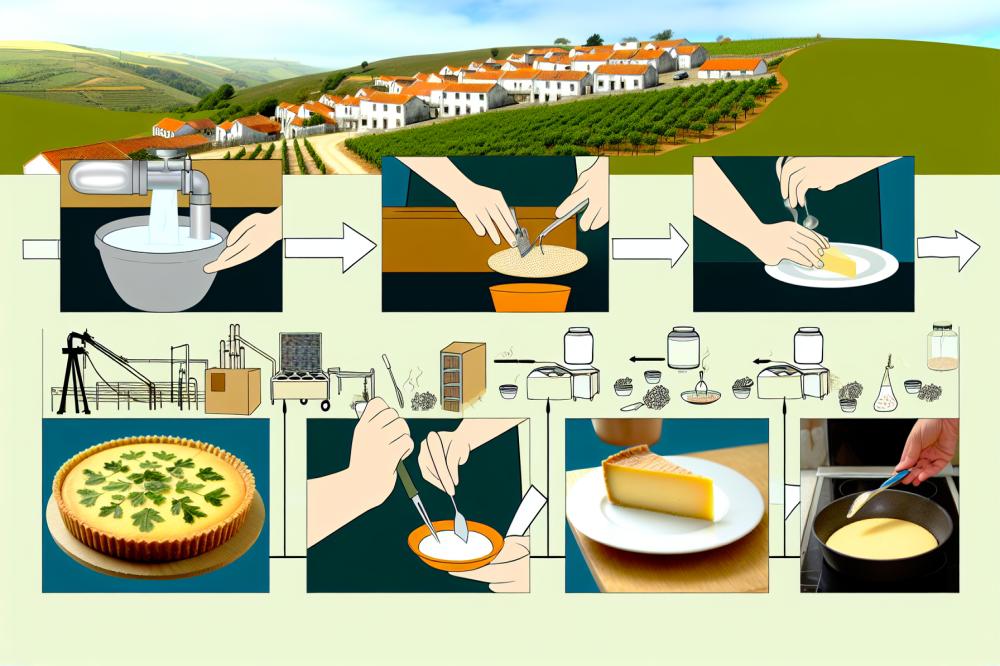Exploring the Bold flavors of Queijo São Jorge
Queijo São Jorge stands out as a remarkable Portuguese cheese, celebrated for its bold flavors and rich history. Originating from the stunning Azores islands, this cheese has a distinct identity. For generations, locals have crafted it using traditional methods, which contribute to its character. Made primarily from raw cow’s milk, the cheese is aged for a minimum of three months, allowing it to develop a robust flavor.
Producers use specific techniques that have been passed down through the years. The milk is collected from cows grazing on lush pastures that are unique to the islands. This grazing process imparts a special quality to the milk, which is then transformed into cheese. During aging, the wheels are turned regularly and monitored closely. This careful attention ensures the development of its strong, slightly spicy taste.
Tasting Queijo São Jorge is an experience. The cheese delights the palate with a creamy texture and a piquant flavor that grows bolder with age. Pairing it with crusty bread or a glass of wine enhances its taste. It works beautifully as part of a cheese board or in traditional Portuguese dishes.
Besides its flavor, this cheese holds cultural significance in Portugal. It represents the craftsmanship and heritage of the Azorean people. Festivals dedicated to cheese celebrate the pride associated with its production. Overall, Queijo São Jorge embodies a piece of Portuguese culture, making it not just a cheese but a symbol of tradition and flavor.
Queijo São Jorge

This distinctive cheese hails from the Azores, a beautiful archipelago in Portugal. Its rich history dates back to settlers who brought dairy traditions and techniques to the islands. The island of São Jorge, where this cheese is primarily produced, offers a lush environment for grazing livestock. The geography includes rolling hills and volcanic soil, which nourishes the pastures and influences the flavor of the milk.
Cows are the main source of milk for this cheese. These cattle graze on local grasses, which contribute to the cheese’s exceptional taste. The milk is often unpasteurized, providing a fuller flavor profile. This raw milk creates a hearty base that enriches the final product. Producers typically use whole milk, which enhances the creaminess and depth of flavor.
Aging Process
Aging is a crucial part of the cheese-making process. Cheese is typically aged for a minimum of three months, but some varieties mature for over a year. During aging, the cheese develops a natural rind that adds to its character. Throughout this period, microbial activity influences texture and flavor. The longer it matures, the sharper and more complex the taste becomes.
Regional Variations
Different producers have their own methods, leading to variation across the islands. Factors such as climate and farming practices can influence these differences. Some cheesemakers might opt for specific breeding practices for their cows. Others may experiment with the aging conditions, resulting in unique flavor profiles unique to certain areas.
Sensory Attributes
Aroma plays a significant role in the overall experience. The smell often reflects the grassy pastures of São Jorge. As one gets closer, a distinct scent of earthiness and hints of nuttiness emerge. Taste also carries bold characteristics. Aged varieties provide a robust flavor, while younger options offer a creamier, milder palate. Many describe it as a blend of buttery and slightly tangy notes.
Texture varies based on aging time. Younger cheeses tend to be softer and creamier, while aged versions become firmer with a granular quality. This complexity allows for a delightful mouthfeel. Pairing it with bread or fruits can enhance the enjoyment, highlighting its depth.
Portuguese cheese

Portugal offers an array of delicious cheeses that reflect its rich culinary tradition. Each variety has distinct flavors and textures, adding depth to the country’s cuisine. One notable cheese is Queijo da Serra. This cheese originates from the Serra da Estrela region. It is made from sheep’s milk. Its creamy, buttery taste varies with age, making it a favorite among cheese lovers.
Queijo de Azeitão deserves attention as well. This cheese is soft and made from sheep’s milk, similar to Queijo da Serra. It carries a slightly tangy flavor and a fragrant aroma. The hand-made process contributes to its artisanal quality. Cheese aficionados often enjoy it spread on crusty bread or paired with a robust red wine.
Another significant cheese is Queijo de São Miguel. Hailing from the Azores, this semi-hard cheese is made from cow’s milk. Its rich, nutty flavor is enhanced by the island’s lush pastures. People often use it in cooking due to its melting qualities, making it a perfect addition to various dishes.
Then there’s Queijo Cabra, made from goat’s milk. This cheese stands out with its tangy flavor and crumbly texture. Often sold fresh, it can also be aged to find sharper notes. Many people slice it over salads or incorporate it into appetizers.
These cheeses greatly contribute to Portugal’s culinary identity. They pair well with local wines, enhancing each bite’s experience. From cheese boards that feature various textures to recipes that highlight their unique flavors, Portuguese cheeses are central to many meals. Travelers and locals alike often seek out these delicacies, demonstrating the nation’s pride in its cheesemaking heritage.
Recipe: Queijo São Jorge Tart

Ingredients
- 200g Queijo São Jorge, grated
- 1 pre-made pastry crust
- 3 large eggs
- 200ml cream
- Salt and pepper to taste
- Fresh herbs for garnish
Instructions
- Preheat your oven to 180°C (350°F).
- In a mixing bowl, whisk together the eggs and cream.
- Next, stir in the grated cheese and season your mixture with salt and pepper.
- Pour this mixture into the pastry crust you prepared.
- Bake for 30 to 35 minutes, or until it is set and golden on top.
- Allow it to cool slightly before serving. Garnish with fresh herbs for an added touch.
Nutritional Information
Each serving contains approximately 250 calories, with 8 grams of protein. The fat content is about 20 grams, while carbohydrates make up roughly 15 grams. These numbers give you insight into how the tart fits into your diet.
Health Benefits
This cheese is not only flavorful but also beneficial. It is rich in protein, which is essential for muscle repair and overall health. Calcium levels in the cheese contribute significantly to bone strength and health. Incorporating this tart into your meals can help you reach necessary nutritional goals. Balancing flavor and nutrition in your diet is always a good choice.
Embracing the Essence of Queijo São Jorge

Queijo São Jorge holds a special place in the heart of Portuguese cuisine. Its bold flavors inspire chefs and home cooks alike. This artisanal cheese is not just a food item; it represents the rich heritage of the Azores. With its distinct taste and appealing texture, it can elevate any dish. Pair it with bread, olives, or fruits to explore its versatility.
Some might not realize how easy it is to incorporate this cheese into everyday meals. Whether melted into a hearty casserole or sliced on a cheese board, each serving tells a story. Traditional recipes often highlight its capabilities, inviting everyone to get creative.
Culinary adventures await those who are willing to try new combinations. Cooking with this cheese can provide a deeper understanding of Portuguese culture. When preparing a meal featuring Queijo São Jorge, many are reminded of family gatherings and celebrations.
Trying a homemade recipe can deepen appreciation for this iconic ingredient. Savoring its richness and complexity brings a bit of Portugal into your kitchen. Encouragement comes to explore its uses and share the experience with family and friends.
In every bite, this cheese speaks of unity and tradition. Allow its legendary flavors to transport you to the vibrant landscapes of the Azores. Don’t miss the chance to immerse yourself in the culinary traditions connected to Queijo São Jorge.



